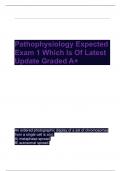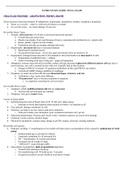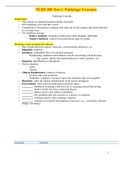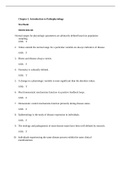Mhc restriction - Study guides, Class notes & Summaries
Looking for the best study guides, study notes and summaries about Mhc restriction? On this page you'll find 26 study documents about Mhc restriction.
Page 3 out of 26 results
Sort by

-
Pathophysiology Expected Exam 1 Which Is Of Latest Update Graded A+
- Exam (elaborations) • 48 pages • 2024
-
- $2.99
- + learn more
________________________________________ Pathophysiology Expected Exam 1 Which Is Of Latest Update Graded A+ An ordered photographic display of a set of chromosomes from a single cell is a(n): A) metaphase spread. B) autosomal spread. C) karyotype. D) anaphase spread. - ANSWER-c An error in which homologous chromosomes fail to separate during meiosis is termed: A) aneuploidy. B) nondisjunction. C) polyploidy. D) anaplasia. - ANSWER-b A somati...

-
Stony Brook University BIO 310/BIO310 All Lecture quizzes (answered) study this for a 100% A grade.
- Other • 61 pages • 2022
-
- $15.49
- + learn more
Quiz questions based on Lecture 13 (Signaling-1). 1. What is always present in a signaling pathway? A. Signal that originates outside a cell B. Signal that remains outside the responding cell during signaling C. Cell-surface receptor D. A and B are correct 2. Adrenaline is a signal used in the fight-or flight response. Adrenaline signaling is A. Endocrine B. Paracrine C. Autocrine D. Contact-dependent 3. One signal can have different effects on the same cell; for example, it can alter...

-
PATHO STUDY GUIDE: FINAL EXAM!
- Exam (elaborations) • 75 pages • 2021
-
- $9.99
- + learn more
PATHO STUDY GUIDE: FINAL EXAM! Stress increases functional demand adaptations: hypertrophy, hyperplasia, atrophy, metaplasia, dysplasia) Stress is reversible – when it’s relieved cell returns to normal Irreversible stress – too much damage necrosis Reversible Stress Types 1. Atrophy: decreased size of cell due to decreased functional demand Overall decrease tissue mass Muscle can atrophy if not used because of injury, neuromuscular dysfunction (i.e. spinal co...

-
NURS 208 Test 1- Pathology Concepts | graded A
- Exam (elaborations) • 47 pages • 2021
-
- $10.99
- 1x sold
- + learn more
Pathology Concepts Homeostasis • The tendency to maintain balance/stability internally • Self-regulating, give-and-take system • Compensatory mechanisms: strategies that make up for the chan ges and return the body to its normal state • Two feedback systems: - Positive feedback: formation of blood clot while bleeding, child birth - Negative feedback: control of elevated blood sugar by insulin Histology: cause or reason for a disease • May include infectious agents, chemicals, environme...

-
PATHOPHYSIOLOGY 370 FINAL EXAM STUDY GUIDE.
- Other • 57 pages • 2021
-
- $10.99
- + learn more
Chapter 1: PATHOPHYSIOLOGY 370 FINAL EXAM STUDY GUIDE 1. Etiology: study of causes or reasons for a particular injury. Idiopathic (unknown) vs Iatrogenic (unintended/unwanted medical treatment ). Risk Factor: a factor that increases the likelihood of disease. 2. Pathogenesis: development or evolution of disease from initial stimulus to ultimate expression of manifestations of the disease. 3. Clinical Manifestations: Signs (objective) vs Symptoms (subjective). 4. Stages and Clinical Course: Laten...

-
EXAM 1/ (Chapter 1: Introduction to Pathophysiology Test Bank) /Test Bank Exam Tested Questions and Answers
- Exam (elaborations) • 47 pages • 2021
-
- $10.99
- + learn more
Chapter 1: Introduction to Pathophysiology Test Bank TRUE/FALSE 1.Normal ranges for physiologic parameters are arbitrarily defined based on population sampling. ANS: T 2. Values outside the no rmal range for a particular variable are always indicative of disease. ANS: F 3. Illness and disease always coexist. ANS: F 4. Normalcy is culturally defined. ANS: T 5. A change in a physiologic variable is more significant than the absolute values. ANS: T 6. Most homeostatic mechanisms function via positi...

Study stress? For sellers on Stuvia, these are actually golden times. KA-CHING! Earn from your study resources too and start uploading now. Discover all about earning on Stuvia


